Related Research Articles
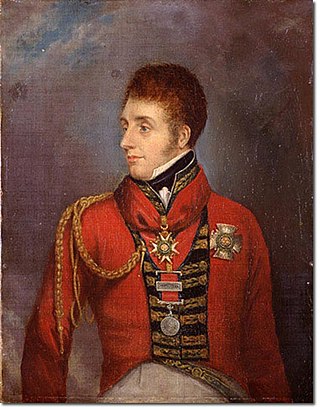
Major-General Hon. Sir William Ponsonby was an Anglo-Irish politician and British Army officer who served in the Peninsular War and was killed at the Battle of Waterloo.
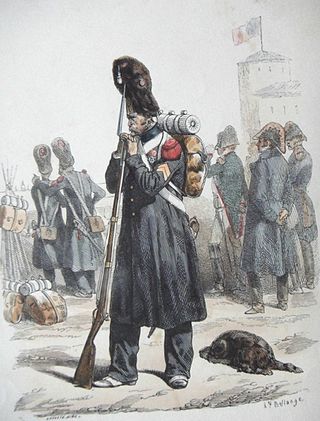
The Imperial Guard was originally a small group of elite soldiers of the French Army under the direct command of Napoleon I, but grew considerably over time. It acted as his bodyguard and tactical reserve, and he was careful of its use in battle. The Guard was divided into the staff, infantry, cavalry, and artillery regiments, as well as battalions of sappers and marines. The guard itself as a whole distinguished between the experienced veterans and less experienced members by being separated into three sections: the Old Guard, Middle Guard and Young Guard.

The King's German Legion was a British Army unit of mostly expatriated German personnel during the period 1803–16. The legion achieved the distinction of being the only German force to fight without interruption against the French during the Napoleonic Wars.

The Battle of Sehested was fought between Danish and Russian-Prussian-British troops at Sehested on 10 December 1813 during the War of the Sixth Coalition. The Danish Auxiliary Corps, which fought on the side of the French defeated the coalition forces commanded by Major General Ludwig von Wallmoden-Gimborn.
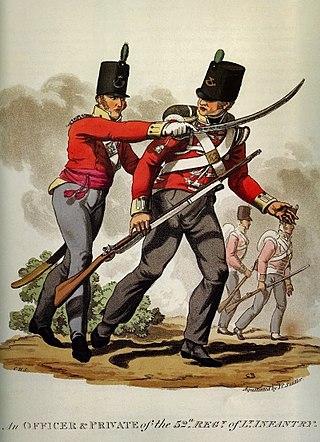
The Coalition forces of the Napoleonic Wars were composed of Napoleon Bonaparte's enemies: the United Kingdom, the Austrian Empire, Kingdom of Prussia, Kingdom of Spain, Kingdom of Naples, Kingdom of Sicily, Kingdom of Sardinia, Dutch Republic, Russian Empire, the Ottoman Empire, Kingdom of Portugal, Kingdom of Sweden, and various German and Italian states at differing times in the wars. At their height, the Coalition could field formidable combined forces of about 1,740,000 strong. This outnumbered the 1.1 million French soldiers. The breakdown of the more active armies are: Austria, 570,000; Britain, 250,000; Prussia, 300,000; and Russia, 600,000.
The Battle of Venta del Pozo, also known as the Battle of Villodrigo by the French and Spanish, was a rear-guard action fought as part of the Peninsular War on 23 October 1812 between an Anglo-German force led by Major-General Stapleton Cotton against French cavalry under Major-Generals Jean-Baptiste Curto and Pierre François Xavier Boyer. The result was a French victory.

Lieutenant-General Robert Ballard Long was an officer of the British and Hanoverian Armies who despite extensive service during the French Revolutionary and Napoleonic Wars never managed to achieve high command due to his abrasive manner with his superiors and his alleged tactical ineptitude. Although he remained a cavalry commander in the Peninsular War between 1811 and 1813, the British commander Wellington became disillusioned with Long's abilities. Wellington's opinion was never expressed directly, though when the Prince Regent manoeuvred his favourite, Colquhoun Grant into replacing Long as a cavalry brigade commander, Wellington conspicuously made no effort to retain Long. Other senior officers, including Sir William Beresford and the Duke of Cumberland, expressed their dissatisfaction with Long's abilities. The celebrated historian, and Peninsula veteran, Sir William Napier was a severe critic of Beresford's record as army commander during the Albuera Campaign; in criticising Beresford he involved Long's opinions as part of his argument. The publication of Napier's history led to a long running and acrimonious argument in print between Beresford and his partisans on one side, with Napier and Long's nephew Charles Edward Long on the other. Recently, Long's performance as a cavalry general has received more favourable comment in Ian Fletcher's revisionist account of the British cavalry in the Napoleonic period.

The Battle of Majadahonda saw an Imperial French cavalry division led by Anne-François-Charles Trelliard attack two brigades of cavalry under Benjamin d'Urban and forming the advance guard of Arthur Wellesley, Earl of Wellington's army. Trelliard's leading brigade routed d'Urban's Portuguese horsemen and overran three British cannons. King's German Legion (KGL) cavalry led by Eberhardt Otto George von Bock intervened to halt the Imperial French horsemen, but were finally compelled to withdraw when Trelliard committed his second and third brigades to the contest. The Imperial French cavalry was unable to cope with a KGL infantry battalion defending a village and they withdrew at the approach of additional British cavalry and infantry. This Peninsular War action was fought near Majadahonda, which is located 16 kilometres (9.9 mi) northwest of Madrid.

In the Battle of García Hernández on 23 July 1812, two brigades of Anglo-German cavalry led by Major-General Eberhardt Otto George von Bock defeated 4,000 French infantry led by Major-General Maximilien Foy. In what would otherwise have been an unremarkable Peninsular War skirmish, the German heavy dragoons achieved the unusual feat of breaking three French squares, those of the 6th, 69th and 76th Line, routing the entire French force with heavy losses.

The British Army during the Napoleonic Wars experienced a time of rapid change. At the beginning of the French Revolutionary Wars in 1793, the army was a small, awkwardly administered force of barely 40,000 men. By the end of the period, the numbers had vastly increased. At its peak, in 1813, the regular army contained over 250,000 men. The British infantry was "the only military force not to suffer a major reverse at the hands of Napoleonic France."
Digby Smith is a British military historian. The son of a British career soldier, he was born in Hampshire, England, but spent several years in India and Pakistan as a child and youth. As a "boy soldier", he entered training in the British Army at the age of 16. He was later commissioned in the Royal Corps of Signals, and held several postings with the British Army of the Rhine.
Lieutenant-General Sir James Frederick Lyon was a distinguished officer of the British Army who served as Governor of Barbados from 1829 to 1833.
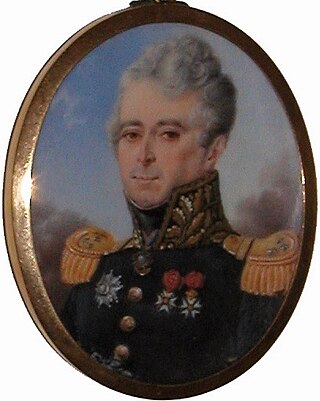
Anne-François-Charles Trelliard or Treillard or Treilhard, born 7 February 1764 – died 14 May 1832, joined the cavalry of the French Royal Army as a cadet gentleman in 1780. During the French Revolutionary Wars he fought in Germany and Holland, eventually rising in rank to become a general officer in 1799. He led a corps cavalry brigade at Austerlitz in the 1805 campaign. In the 1806-1807 campaign he fought at Saalfeld, Jena, and Pultusk.

Antoine Maurin commanded a French cavalry division in 1814 during the Napoleonic Wars and in 1815 led his troops against the Prussians at Ligny where he was wounded. His army service began in 1792 during the French Revolution when he enlisted in a cavalry regiment as a trooper. He spent his entire military career as a cavalryman. During the French Revolutionary Wars he advanced through the ranks and became commander of a light cavalry regiment in 1802. While only a colonel, he commanded a brigade at Caldiero in October 1805. He fought in the Friedland campaign in 1807 and attained the rank of general officer that year. As a cavalry brigadier, he participated in the 1807 Invasion of Portugal but was captured in 1808 and held until 1812. He led a brigade in 1813 and a division 1814 during the War of the Sixth Coalition. After fighting for Napoleon during the Hundred Days, he retired in 1823. His surname is one of the names inscribed under the Arc de Triomphe, on Column 40.
The III Cavalry Corps of the Grande Armée was a French military unit that existed during the Napoleonic Wars. The corps was created in 1812 and reconstituted in 1813 and 1815. Emperor Napoleon Bonaparte first mobilized the corps for the invasion of Russia. Commanded by General Emmanuel de Grouchy, two divisions of the corps fought at Borodino, Tarutino, and Vyazma. A third division fought at the First and Second battles of Polotsk and the Berezina. During the War of the Sixth Coalition in 1813, General Jean-Toussaint Arrighi de Casanova led the corps at Großbeeren, Dennewitz, Leipzig, and Hanau.
Jean Marie Antoine Philippe de Collaert led the Dutch-Belgian cavalry division at the Battle of Waterloo. He became an officer in the Habsburg Austrian cavalry in 1778 and later served in the Dutch Republic army until 1786. After the armies of the First French Republic overran the Dutch Republic in 1795, Collaert became a lieutenant colonel of hussars in the new army of the Batavian Republic, a French satellite state. He fought with distinction at the Battle of Castricum in 1799 and was badly wounded fighting the Austrians in 1800. He was promoted colonel in 1803. Under the Kingdom of Holland he became a major general in 1806 and colonel-general of the King's Bodyguard in 1808.
Major General Sir Granby Thomas Calcraft (1770–1820) was a British soldier and politician. He was a cavalry officer, and commanded the 3rd Dragoon Guards and the Heavy Brigade in the Peninsular War. He was MP for Wareham in the years 1807–1808.
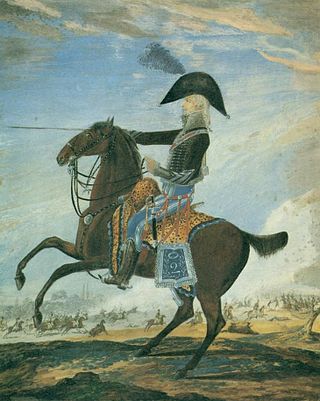
Charles Étienne de Ghigny commanded a Kingdom of the Netherlands light cavalry brigade at the Battle of Waterloo. He joined a French light cavalry regiment in 1792 and served in the same regiment for 22 years, becoming its lieutenant colonel in 1806. He fought in the Peninsular War in 1810–1811 and in the latter year became colonel of the regiment. He fought in the 1812 French invasion of Russia, the 1813 German Campaign and the 1814 French Campaign. In 1814 he led a cavalry regiment at Fère-Champenoise and Paris. He changed his allegiance to the Netherlands in 1815 and was appointed major general. He was promoted to lieutenant general in 1826. He switched allegiance to the Kingdom of Belgium in 1831 and received the Order of Leopold in 1837.

Charles Claude Jacquinot commanded a French cavalry division at the Battle of Waterloo in 1815. He joined a volunteer battalion in 1791 and transferred to a light cavalry regiment as a junior officer in 1793. He earned promotion to squadron commander and was acting commander of his regiment at Hohenlinden in 1800. After serving in a staff position at Austerlitz in 1805, he led a light cavalry regiment at Jena in 1806. Promoted to general of brigade he led his horsemen at Abensberg, Raab and Wagram in 1809. During the French invasion of Russia he fought at Ostrovno, Smolensk and Borodino in 1812. During the 1813 German Campaign he led a cavalry brigade at Dennewitz and Leipzig. After being appointed general of division he fought at Second Bar-sur-Aube and Saint-Dizier in 1814. During the Hundred Days he rallied to Napoleon and led a light cavalry division in the Waterloo campaign. After 15 years of inactivity, he was restored to favor in the 1830s. Thereafter he held a number of commands and was appointed to the Chamber of Peers. His surname is one of the names inscribed under the Arc de Triomphe, on Column 20.
The French Imperial Army was the land force branch of the French imperial military during the Napoleonic era.
References
- Haythornthwaite, Philip. British Cavalryman 1792-1815. Warrior Series. Osprey. p. 54.
Attribution
 This article incorporates text from a publication now in the public domain : Chichester, Henry Manners (1886). "Bock, Eberhardt Otto George von". In Stephen, Leslie (ed.). Dictionary of National Biography . Vol. 5. London: Smith, Elder & Co. p. 287.
This article incorporates text from a publication now in the public domain : Chichester, Henry Manners (1886). "Bock, Eberhardt Otto George von". In Stephen, Leslie (ed.). Dictionary of National Biography . Vol. 5. London: Smith, Elder & Co. p. 287.